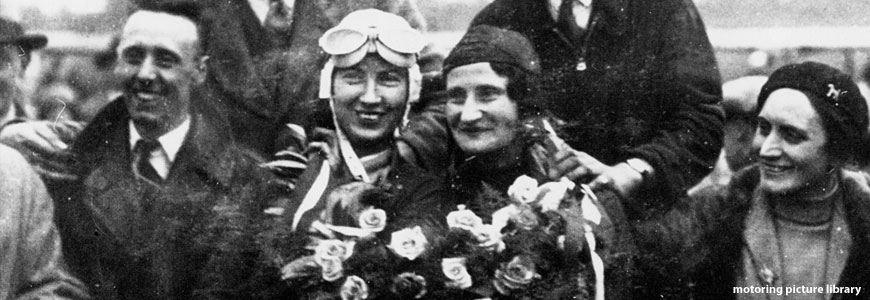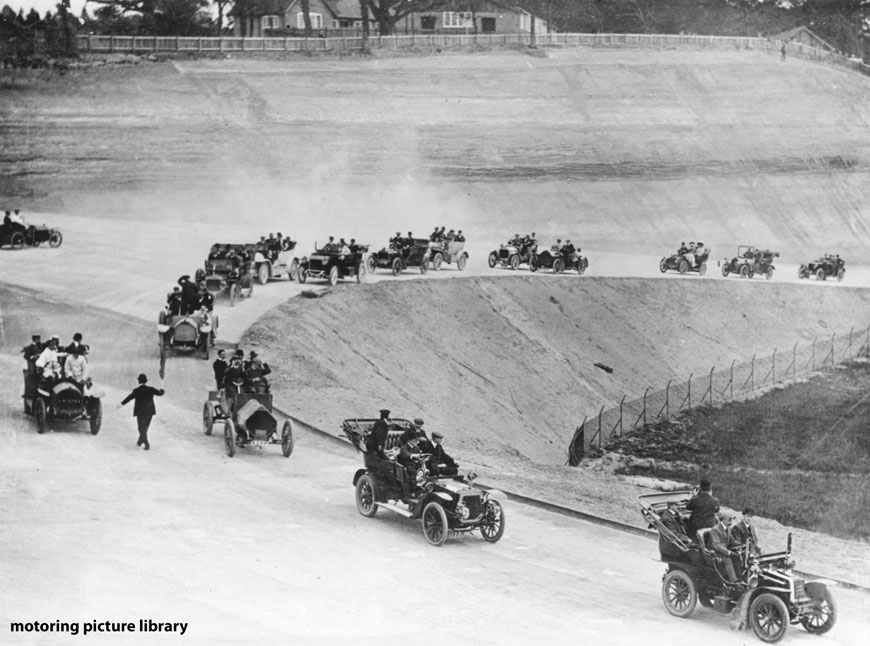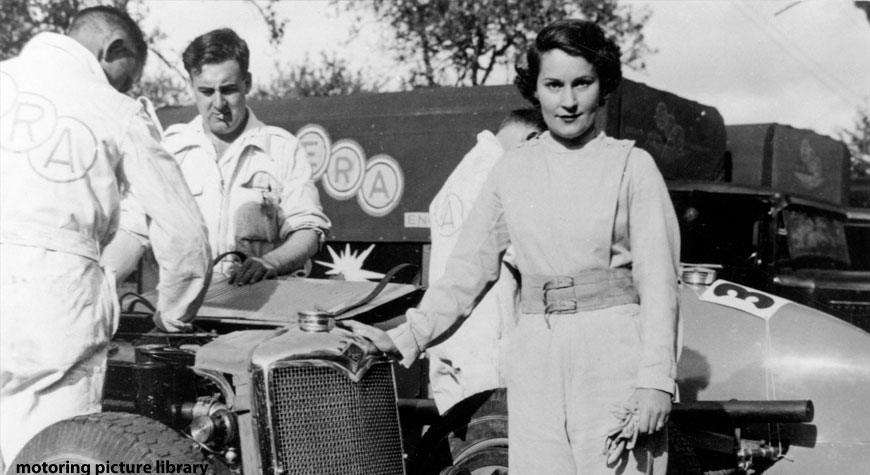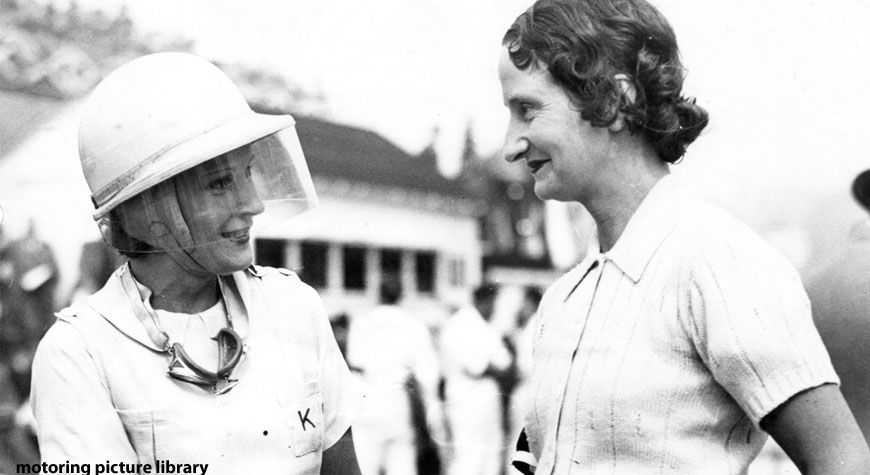
Brooklands, the first purpose-built racetrack in the world, has played host to a number of remarkable women – nicknamed The Belles of Brooklands.
At the beginning of the 20th Century, Oscar Wilde, who wrote The Portrait of Dorian Gray commented, “My dear boy, no woman is a genius – women are the decorative sex.” Sadly this opinion was not uncommon and it was regarded as positively outrageous and shocking if a woman considered motoring at all – let alone enter a road race!
When Brooklands opened in 1907 it was the first purpose-built racetrack in the world, enabling the great marques to compete against one another. But initially the Brooklands Automobile Racing Club (BARC) did not permit women to race on the circuit.

Ladies Bracelet Handicap
In 1908 the rules were relaxed somewhat for the Ladies Bracelet Handicap. In order to distinguish themselves, and to add a dash of glamour, the female competitors wore coloured outfits and scarves; making sure they secured their skirts with pieces of cord so that they would not suffer the embarrassment of them riding up over their knees. And of course the cars tended to be stripped down to the bare minimum to save weight – but not necessarily sparing blushes! There were eight women taking part with Muriel Thompson winning with her Austin and just beating Ethel Locke-King, wife of Hugh, who was driving John Scott Montagu’s Itala. Coming in third was the statuesque Christabel Ellis in an Arrol-Johnston. Although no speeds were announced there is no doubt that the finish had been close.
Women Banned From Racing!
Following the Bracelet the BARC took the decision that women would not be permitted to race at their meetings, declaring there were no lady jockeys, so why should there be female racing drivers? The press were outraged but the officials remained resolute.
It was not until 1928 when the BARC finally conceded by allowing women to compete in Ladies-only Handicaps and after yet more pressure, they were finally allowed to test their skills against the men in 1932.
There is no doubt that after WWI, during which time women had served their country and were expected to take on men’s roles, Brooklands helped ‘launch’ them further and thus provided them access to a male-dominated sport which was initially only for the affluent rich.
The Belles of Brooklands
Here are some examples of a number of the most iconic Belles of Brooklands:
Kay Petre

Kay Petre, born Kathleen Coad Defries on the 10th May 1903 in Toronto was the darling of the Brooklands circuit. This ravishing brunette, under 5′ tall, always dressed immaculately in her favourite pale blue racing overalls. Kay moved to England with her husband Henry in 1930, having married the previous year. Already a skilled and competitive sportswoman, especially in ice skating, she soon was bitten by the motoring bug and by 1933 Kay was driving 2 litre Bugattis in the Handicap races. She is also famous for driving the huge V12 engined Delage cars, taking the Ladies Land Speed Record at 134.75mph, also in 1933.
Keen to drive different types of racing cars, Kay frequently chatted up the male drivers and wasted no time in asking if she could ‘have a go’ – naturally they were flattered and agreed!
In 1937 Kay survived a horrific accident during practice for the Brooklands 500 miles when a fellow driver, Reg Parnell stalled above her in his MG, slid down and ploughed into her Austin Seven which rolled down the banking, crushing her underneath. She suffered severe head injuries and was in a coma for several days. She underwent surgery to her face and head but suffered permanent paralysis to one side. She made the decision to give up racing and turned to rallying, primarily as a navigator with Singer cars.
Following WWII Kay began working as a motoring journalist and was later employed by Austin on its design team, choosing colours for the interior of the mini, amongst other models. This was always pale blue.
Henry died in 1962 and Kay never remarried, living in London and maintaining her interest in motorsport by attending race meetings. She died on 10th August 1994 and is mentioned in the Montreal Hall of Fame. She will be remembered affectionately as ‘the firecracker of the family.’
Beatrice (Tilly) Shilling OBE
Born 8th March 1909 in Hampshire, Beatrice showed her passion for speed at the age of fourteen when she bought herself a motorcycle, having made up her mind to become an engineer. After working for a small electrical engineering company in Devon, installing wiring and generators, she went on to study electrical engineering at Manchester University in 1929.
During the 1930s Beatrice regularly raced motorcycles around the Brooklands circuit and was awarded the Gold Star for lapping the circuit at 106mph on her Manx Norton – faster than any other woman on two wheels and subsequently making a huge impact in a male-dominated field. She was once described as a ‘Flaming Pathfinder of Womens’ Lib’ and throughout her life fought against any suggestion that as a woman she might be inferior to her male colleagues.
In 1936 when jobs were obviously extremely difficult to come by, Beatrice was employed by the Royal Aircraft Establishment as a scientific officer, based in Farnborough. During WWII she worked on a number of projects, the most famous of which was known as Miss Shilling’s Orifice – a small metal disc with a hole in the middle which was fitted into the Spitfire engine’s carburettor which restricted fuel flow; thereby preventing flooding. This continued in use as a stop-gap until the introduction of the pressure carburettor in 1943. Beatrice continued working at the RAE until her retirement in 1969. She was awarded an OBE for her work during WWII and died on the 18th November 1990.
Elsie ‘Bill’ Wisdom

Elsie Wisdom was a Tomboy and no mistake! Born in 1904, Elsie had six brothers who nicknamed her Bill and she didn’t disappoint them. When she was sixteen Bill was riding her own motorbike much to the alarm of her parents who, concerned about her high speed escapades bought her a small GWK cyclecar. This did not go down too well and Bill swapped this for a supercharged Lea-Francis and a Frazer-Nash which, incidentally she drove in the Trials at Brooklands on the 21st March 1930 for the opening season.
Tommy Wisdom was working as a journalist for a motor sports magazine when he met Bill and instantly fell in love with her and together this awesome pair competed in many events, including a hillclimb race at Shelsley Walsh which Bill won. She also raced with the Australian Joan Richmond in a Riley 9 in the 2×12 hour relay and the 1932 Thousand Miles – this they won, victorious over all the male drivers and the best European works teams. In 1937 the couple were again competing in the Thousand Miles in an MG but smashed into a tree to avoid a pedestrian. Tom suffered a broken leg and Bill sustained severe facial injuries.
After WWII Bill took part in several Monte Carlo rallies between 1949 and 1951 and in the 1951 Alpine Cup with Tommy. This almost ended in tragedy when an American tourist ploughed into their Bristol. Destiny perhaps? Was this the realisation that perhaps it was time to make way for another awesome pair – Tommy and Bill’s daughter Anne known as ‘Wizz’ and her colleague Pat Moss, ‘Mossie’ – who went on to claim many victories in their Austin Healey.
Next time: the beautiful and charismatic Maria Teresa de Filippis – first woman to make a Grand Prix Grid.
Sarah Crofts has been sharing her passion for motorsport with Beaulieu’s visitors since she first joined as a volunteer in 2007. Now a Museum Attendant, she has grown to love her role more and more and can’t imagine doing anything else! Sarah’s popular Women in Motorsport tour is one of several daily tours on offer in the National Motor Museum.
